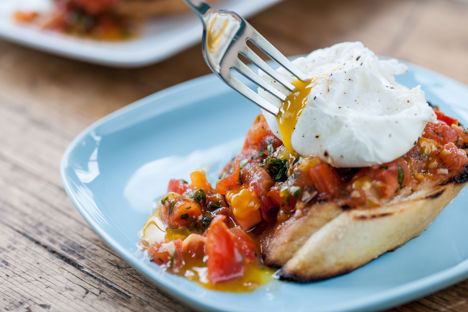
5 easy egg hacks to save you time
Wave good riddance to lacklustre poaching and fiddly peeling. We’ve turned to our in-house experts and top chefs for their tips to make egg cookery a breeze.
5 easy egg hacks to save you time
Wave good riddance to lacklustre poaching and fiddly peeling. We’ve turned to our in-house experts and top chefs for their tips to make egg cookery a breeze.
A frittata using up what’s in the fridge, a crispy fried egg on top of fried rice or a soft-boiled number to finish a salad – having eggs on hand is never a bad thing. An easy way to pep up a meal (or create one from nothing), they’re cheap, healthy and delicious. And though they’re pretty straightforward to cook, that doesn’t mean they don’t come without challenges; we’ve all ended up with a rather uninspiring poached egg or an omelette which looks more mess than masterpiece.
With a few simple trips and tricks, you'll be on the right track in no time. With that in mind, we’ve pulled together some quick pointers to guarantee you’re getting your eggs right first time. We’ve asked our in-house recipe experts for their pearls of wisdom, as well as taking some pointers from viral online methods and top chefs.
Speedy peeling
The simple task of peeling an egg can be anything but; we've all stood over the kitchen sink painstakingly peeling away to avoid the membrane sticking. To speed up the process, our team recommends tapping the flatter base of the egg (before you boil it) with a spoon until you hear a slightly louder tap. That sound is the membrane releasing itself, which will make peeling it much easier when the time comes. You can also prick a tiny hole into the base with a pin, which also helps.
When it’s time to peel, do so under cold, running water, and use a spoon to ease off the shell if you’re in a hurry. And while we can’t vouch for the success of this one, the internet is a fan of another method; fill a shallow, plastic container halfway with cold water. Place the hard-boiled egg in there, seal it and then shake for about ten seconds – the shell is meant to slide right off. We think slow and steady might win the race, though..
Perfect poaching
Poaching is one of the more daunting ways to cook eggs – plenty of us are happy to leave that to the pros, but it's much easier than you might think once you have a routine down. Using fresh eggs, and ideally keeping them in the fridge until you’re ready to poach, is always wise; fresh, chilled eggs are much more likely to hold together when poaching. However, to land those perfectly-shaped poached eggs, our team’s top tip is to crack each egg individually into a sieve ahead of cooking. This gets rid of loose, wispy whites and means that, when the egg goes into the water, it holds its shape.
Cracking omelettes
Healthy, incredibly filling and versatile, omelettes are an unbeatable meal at any time of the day. While we love an omelette Arnold Bennett or a Spanish tortilla, if you're whipping up a more classic, French-style omelette with beautifully smooth sides, listen up. As you roll it up with a spatula, we add small cubes of butter to the pan as we go – it stops the omelette from cracking, meaning you'll end up with the cheffy omelette of our dreams.
No bad eggs
It's tricky to know confidently when eggs have gone bad (we're sure a few of you have learned the hard way after eating one slightly past its best). Next time you're not sure, pop them in a bowl of water – if they sink, they're good to go. If they float, it's a bad sign, as it means its air cell has grown enough to keep it buoyant – a sign of old age. Though it doesn't mean the egg is off on every occasion, it's a signal that it's worth a sniff and a closer look.
Get the yolk?
Getting the yolks out of hard-boiled eggs might not be an everyday task, but it’s one you’ll need to do in bulk if you’re whipping up a batch of devilled eggs. When it comes to getting the yolks out, it's not easy to do without making a mess and cutting the yolks in half too. But an internet hack suggests we treat the egg like an avocado, using a knife to cut gently around the yolk and not through it. Simply place your knife so that it's on the vertical line of your egg (pointing towards the tip) and then pull the knife backwards gently, rolling the egg as you go, so that you cut through the white the whole way around. The yolk should then pop right out. Fuss-free!


